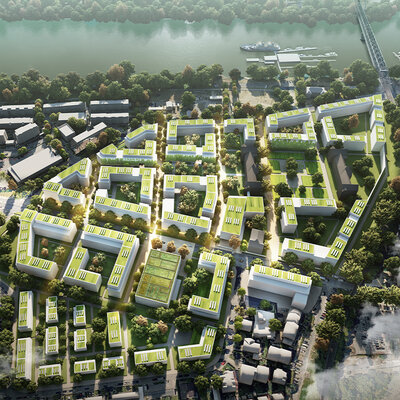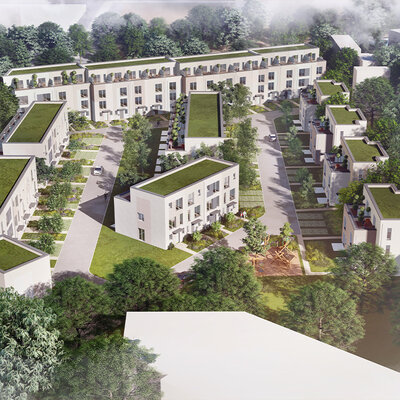Olympia becomes a city – here to stay
Rhine-Ruhr region
The concept for an athletics stadium for a possible bid by the state of North Rhine-Westphalia for the 2040 Olympic and Paralympic Games is based on the model of ancient sports facilities and stadiums that have been converted to other uses over the course of time in central city centre locations. Today, they are examples of some of the most beautiful and famous squares in the history of urban development. This very important part of the city's history, which was uniquely characterised by sport, is now to be continued in a forward-looking way.
In North Rhine-Westphalia, fully developed sites are available for future development in prime city centre locations. The Olympic athletics stadium forms the nucleus of this development. The stadium is seen as an interim use and is therefore centrally positioned in the emerging neighbourhood. It forms the central anchor point for the design and at the same time the striking symbol of sustainable urban development, which will subsequently become a park as a meeting point for residents and visitors.
The development of the site as a city of short distances places particular emphasis on the integration of living, working and living spaces in an urban density that conserves resources. The current challenges of the circular economy, climate-friendly construction, regenerative energy generation, multi-mobility and the digital city are given a new solution with this vision.
The building structure of the stadium is designed from the outset to be rebuilt and extended on a modular basis. The recognisable advantage is that significantly less material expenditure and financial investment is required overall.
planquadrat developed this design for an innovative and consistently sustainable urban neighbourhood in close cooperation with the landscape architecture firm geskes.hack from Berlin, the Fraunhofer Institute and the GROPYUS company.
‘With our vision for the athletics stadium for the bid for the Olympic Games in NRW, we are combining the power of sport with the future of new construction - both areas are about sustainability today. We are not primarily creating a sports facility. What is new is that this stadium, in its basic structure, will be the spatial basis for a new, resource-saving urban development based on it. Our plans envisage a modular building structure that can be converted and further developed after the Olympic Games, with flats, offices, day-care centres, sports facilities and a park in the centre. Developing the new city from the Olympics and creating a positive legacy - that's the idea.’
Herbert Elfers










